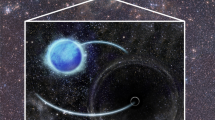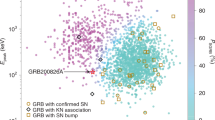Abstract
Burbidge, Lynds and Stockton1 and Kristian, Sandage and Westphal2 have shown that the point X-ray source Cyg X-2 is very probably binary. Kraft and Demoulin3 further suggest that a third object may be present, for their radial velocity observations do not seem to repeat, but the observational uncertainties are such that this possibility will not be considered here.
This is a preview of subscription content, access via your institution
Access options
Subscribe to this journal
Receive 51 print issues and online access
$199.00 per year
only $3.90 per issue
Buy this article
- Purchase on Springer Link
- Instant access to full article PDF
Prices may be subject to local taxes which are calculated during checkout
Similar content being viewed by others
References
Burbidge, E. M., Lynds, C. R., and Stockton, A. N., Astrophys. J., 150, L95, (1967).
Kristian, J., Sandage, A., and Westphal, J. A., Astrophys J., 150, L99, (1967).
Kraft, R. P., and Demoulin, M. H., Astrophys. J., 150, L 183, (1967).
Gursky, H., Gorenstein, P., and Giacconi, R., Astrophys. J., 150, L75, (1967).
Cameron, A. G. W., and Mock, M., Nature, 215, 464 (1967).
Payne-Gaposchkin, C., The galatic Novae (North-Holland Publishing Company, Amsterdam, 1957).
Author information
Authors and Affiliations
Rights and permissions
About this article
Cite this article
SOFIA, S., WILSON, R. Population Type of Cygnus X-2. Nature 218, 73–74 (1968). https://doi.org/10.1038/218073b0
Received:
Issue Date:
DOI: https://doi.org/10.1038/218073b0
Comments
By submitting a comment you agree to abide by our Terms and Community Guidelines. If you find something abusive or that does not comply with our terms or guidelines please flag it as inappropriate.



